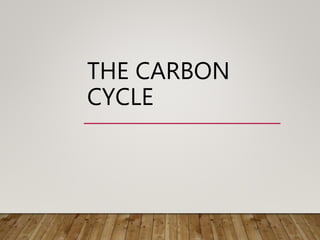Carbon_Cycle.pptx
•Descargar como PPTX, PDF•
0 recomendaciones•28 vistas
carbon cycle
Denunciar
Compartir
Denunciar
Compartir

Recomendados
Recomendados
Más contenido relacionado
Similar a Carbon_Cycle.pptx
Similar a Carbon_Cycle.pptx (20)
Carbon trading, Carbon cycle, Nitrogen cycle, Hydrological cycle

Carbon trading, Carbon cycle, Nitrogen cycle, Hydrological cycle
Último
Faridabad Call Girl ₹7.5k Pick Up & Drop With Cash Payment 8168257667 Badarpur Call Girls
Booking Contact Details
WhatsApp Chat: +91-8168257667
Normal Call : +91-8168257667
Faridabad Call Girls includes providing maximum physical satisfaction to their clients as well as engaging conversation that keeps your time enjoyable and entertaining. Plus they look fabulously elegant;$S2 making an impressionable.
Faridabad Call Girls understands the value of confidentiality and discretion - they will go the extra mile to meet your needs. Simply contact them via text messaging or through their online profiles; they'd be more than delighted to accommodate any request or arrange a romantic date or fun-filled night together.
We provide -
Flexibility
Choices and options
Lists of many beauty fantasies
Turn your dream into reality
Perfect companionship
Cheap and convenient
In-call and Out-call services
And many more.Faridabad Call Girl ₹7.5k Pick Up & Drop With Cash Payment 8168257667 Badarpu...

Faridabad Call Girl ₹7.5k Pick Up & Drop With Cash Payment 8168257667 Badarpu...Hyderabad Escorts Agency
Último (20)
Presentation: Farmer-led climate adaptation - Project launch and overview by ...

Presentation: Farmer-led climate adaptation - Project launch and overview by ...
Vip Salem Call Girls 8250092165 Low Price Escorts Service in Your Area

Vip Salem Call Girls 8250092165 Low Price Escorts Service in Your Area
Faridabad Call Girl ₹7.5k Pick Up & Drop With Cash Payment 8168257667 Badarpu...

Faridabad Call Girl ₹7.5k Pick Up & Drop With Cash Payment 8168257667 Badarpu...
Call Girls Brigade Road ( 8250092165 ) Cheap rates call girls | Get low budget

Call Girls Brigade Road ( 8250092165 ) Cheap rates call girls | Get low budget
Yil Me Hu Spring 2024 - Nisqually Salmon Recovery Newsletter

Yil Me Hu Spring 2024 - Nisqually Salmon Recovery Newsletter
Research.pptxdfdddddddddddddddddddddddddddddddddddd

Research.pptxdfdddddddddddddddddddddddddddddddddddd
Call Girls in Veraval - 8250092165 Our call girls are sure to provide you wit...

Call Girls in Veraval - 8250092165 Our call girls are sure to provide you wit...
Call Girls in Dattatreya Nagar / 8250092165 Genuine Call girls with real Phot...

Call Girls in Dattatreya Nagar / 8250092165 Genuine Call girls with real Phot...
Test bank for beckmann and ling s obstetrics and gynecology 8th edition by ro...

Test bank for beckmann and ling s obstetrics and gynecology 8th edition by ro...
Fuel Cells and Hydrogen in Transportation - An Introduction

Fuel Cells and Hydrogen in Transportation - An Introduction
2024-05-08 Composting at Home 101 for the Rotary Club of Pinecrest.pptx

2024-05-08 Composting at Home 101 for the Rotary Club of Pinecrest.pptx
Environmental Topic : Soil Pollution by Afzalul Hoda.pptx

Environmental Topic : Soil Pollution by Afzalul Hoda.pptx
NO1 Google Kala Jadu Expert Specialist In Qatar Kala Jadu Expert Specialist I...

NO1 Google Kala Jadu Expert Specialist In Qatar Kala Jadu Expert Specialist I...
Introduction to heat waves and Heatwaves in Bangladesh.pptx

Introduction to heat waves and Heatwaves in Bangladesh.pptx
Cyclone Case Study Odisha 1999 Super Cyclone in India.

Cyclone Case Study Odisha 1999 Super Cyclone in India.
Carbon_Cycle.pptx
- 2. WHAT IS CARBON? An element: 6 protons, 6 neutrons The basis of life of earth Found in all earth systems
- 3. CARBON CYCLE • The same carbon atoms are used repeatedly on earth. They cycle between the atmosphere, hydrosphere, geosphere and biosphere.
- 4. PROCESSES THAT TRANSFER CARBON - Photosynthesis - Respiration - Consumption - Decomposition - Combustion (Burning) - Weathering (rocks break down and release carbon) - Dissolve/Vaporize (Between ocean and atmosphere) - Deposition
- 5. ANIMALS CONSUME AND RELEASE CARBON • When organisms eat (consume) plants or other organisms, they take in the carbon and some of it becomes part of their own bodies. • When they breath (respiration) they release carbon.
- 6. PLANTS AND ANIMAL DIE • When plants and animals die, most of their bodies are decomposed and carbon atoms are returned to the atmosphere. • Some are not decomposed fully and end up in geosphere deposits underground (soil, oil, coal, etc.) or at the bottom of ocean.
- 7. NATURAL COMBUSTION • Bush fires , release carbon into the atmosphere and geosphere. • Fire returns carbon to the soil and “cleans out” unhealthy plants, allowing new plants to grow.
- 9. CARBON CYCLE DIAGRAM Carbon in Atmosphere Plants use carbon to make food Animals eat plants and take in carbon Plants and animals die Decomposers break down dead things, releasing carbon to atmosphere and soil Bodies not decomposed — after many years, become part of oil or coal deposits Fossil fuels are burned; carbon is returned to atmosphere (Unbalanced) Carbon slowly released from these substances returns to atmosphere
- 10. UNBALANCED CYCLE - HUMAN IMPACT • Under balanced conditions, fossil fuels release carbon stores very slowly into atmosphere. • When humans burn fossil fuels, it releases a tremendous amount of carbon into the atmosphere over a very short time span. • Increased carbon dioxide in atmosphere increases global warming • Fewer plants mean less CO2 removed from atmosphere
- 11. WHAT IS YOUR CARBON FOOTPRINT? • A carbon footprint is the amount of carbon emitted into the atmosphere by your personal, day-to-day activities. • Examples: Type of car you drive, how far you drive your car, how much electricity you use (electricity primarily comes from burning coal), where the food you buy is grown and airplane flights. • Why do we care?? GLOBAL WARMING
- 12. THINGS YOU CAN DO TO REDUCE YOUR CARBON FOOTPRINT • Promote plant life, especially trees • Buy a fuel efficient vehicle • Purchase locally grown food • Reduce electricity use • Reduce how far/much you drive • Take less airplane trips • Reduce, Reuse, Recycle!